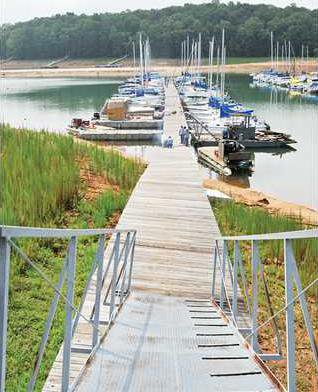0817droughtaud
Len Jernigan talks about Aqualand Marina's drought management plan.A marina has to serve its customers, come hell or high water.
Or in the case of Lake Lanier, low water.
The outlook appears increasingly bleak for Georgia's largest lake. The U.S. Army Corps of Engineers now predicts that Lanier will hit 1,053.2 feet above sea level by Labor Day weekend, and by Sept. 5, the level is expected to reach 1,052.8 feet.
Normal full pool is 1,071. The lowest Lanier has ever been since it was constructed and filled is 1,050.79 feet, recorded last Dec. 26.
Unless the weather pattern changes, within a few weeks the lake will be just 2 feet above that historic low. The lake has never reached this level during the summer recreation season, and the impact now is far greater than it would be in December.
"It's a lot different (in summer), because people are still using their boats," said Vernita Loveridge, area vice president for Westrec, which operates Holiday and Sunrise Cove marinas on Lanier.
Most of the lake's marinas are located in coves, and as the surface area shrinks, there is less water for docks to float on.
"It does get a little tighter as the water gets lower," said Rhonda Kondo, spokeswoman for Aquamarina Lazy Days near Buford.
Lazy Days has 61 "wet" slips, mostly for houseboats, and 570 spaces for dry-stack storage. Customers who use dry storage can launch their boats from the courtesy dock, using a forklift to lower the craft into the water.
"Last August, there was no water in the ‘well,' the area where the forklift launches boats," said Kondo. "We had to launch boats by trailer."
To address that problem, Lazy Days has dredged the cove and bought a new, larger forklift. "The old forklift could only go down 12 feet (below full pool)," Kondo said. "This one can go 18 feet."
Holiday Marina has also done some dredging, down to the 1,050-foot line.
"We've already extended docks and added more footage to walkways. We'll do some more if necessary," said Loveridge. "We'll also be putting some smaller boats in dry storage."
Normally, Holiday Marina has 1,238 wet slips available. "Right now, 140 are unusable," Loveridge said. "(The boats) were either moved to other slips or the owners took them home."
She said shuffling boats from one slip to another can be difficult and time-consuming, because often there are old anchors left in the slips that have to be pulled up by a barge.
If the water level drops extremely low and space becomes more limited, she said, it's possible to put two small boats in one slip. "We haven't had to do that yet, but we will."
Rearranging slips uses manpower and resources, but when a slip can't be used, the marina can't earn income from it. "There's an added expense and also an added cost, in lost revenue," said Loveridge. "But we're trying not to pass that along to our customers."
Aqualand Marina manager Len Jernigan said they've already spent about $600,000 moving docks around. The marina also hired an engineering firm to design a $40,000 drought management plan, modeled after the hurricane plans that coastal marinas use.
The plan kicks in when the lake is at 1,057 feet, and it specifies which of the marina's 35 docks will be moved as the water level continues to drop.
"We're fortunate at Aqualand because we're out on a peninsula rather than in a cove like most marinas," said Jernigan. "We'll be able to function all the way down to 1,035."
As the water line recedes in a cove, docks have to be crowded closer together. But at Aqualand, docks near the shore can be detached, moved out toward the open lake, and reattached to the ends of docks that are already there.
Jernigan said they've been moving one or two docks per week, but it's a major effort. The dock has to be physically cut apart and its electrical connections severed. Then the electrical lines have to be reconnected to an existing dock, the relocated dock has to be anchored, and a new walkway built.
It's too big a job for marina employees, so Aqualand has hired local contractors to do the work.
Jernigan said there are no immediate plans to raise customers' rates, and he hopes the plan will allow nearly all of Aqualand's 1,767 slips to remain usable.
"It's a cost of doing business," he said. "Everybody's doing what they can. All the marinas are being as responsible to their boaters as possible."

